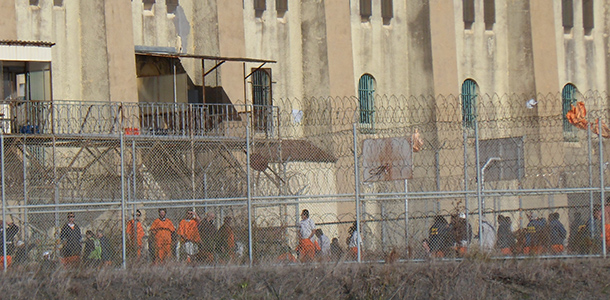
San Quentin state prison (Photo Credit: Zboralski/Flickr)
It was no surprise to those working in county jails across the country when a report released last month showed incarceration has largely replaced hospitalization for the seriously mentally ill.
“As the hospitals and the secure treatment environments have diminished over time, the secure treatment environments have become the prisons and jails across America,” said Terri McDonald, retired jail administrator who's worked in Los Angeles County and the California Department of Corrections and Rehabilitation.
As many as ten times the number of seriously mentally ill are held in state prisons and county jails than the number held at state psychiatric hospitals across the country, according to the report, Individuals With Serious Mental Illnesses in County Jails: A Survey of Jail Staff’s Perspectives, from Public Citizen’s Health Research Group and The Treatment Advocacy Center. McDonald said it wasn’t always this way.
“When the patients would have a bad day or a difficult day or would act out in a hospital, it didn’t lead to criminal convictions, prosecutions or wrong incarceration,” added McDonald. “It was understood that their behavior was based on their mental health disorder and their mental health needs.”
Riverside County is experiencing the problem first hand in its jails, according to the Jail Utilization Study (JUS) conducted by CA Fwd’s Justice System Change Initiative (J-SCI).
“What we’ve found in Riverside is that the mentally ill and Seriously Mentally Ill (SMI) spend more time in jail for lesser crimes,” said Kathy Jett, J-SCI policy consultant. The JUS showed mentally ill offenders have double the bookings than the general jail population and are in jail more than 2.5 times longer. Additionally, the mentally ill were found to be booked mostly for warrants and holds, not new crimes.
“We are using the findings from the Riverside JUS to come up with interventions for the mentally ill and specifically those diagnosed with serious mental illness,” said Jett.
Some of the interventions include developing better data systems to monitor services and tracking jail episodes for offenders suffering from SMI who cycle through jail, continuing multidisciplinary staffing in jail to ensure highest quality interventions for mental health populations and developing an assertive case management approach to increase partnerships among probation, corrections, law enforcement and with mental health professionals to reduce criminal system involvement for the SMI.
“Deputy Sheriffs, correctional officers are not mental health workers,” said McDonald. “They’re trained law enforcement people. So first and foremost, the type of people we’re asking to supervise and manage mentally ill inmates/patients is the wrong classification of people to do that.”
McDonald said there isn’t a silver bullet to solve the situation, but there are steps that can be taken:
- Recognize that certain low-level crimes may be driven by a mental health disorder and not merit custody
- Provide places for law enforcement to take those in a mental health crisis other than jail
- Teach law enforcement about mental health intervention and de-escalation techniques
- Increase urgent care and sobering centers that can prevent the mentally from cycling in and out of jail
- Reevaluate the process of conservatorship, which can provide for oversight over mentally ill persons
“We should begin to teach society that mental illness is not something that we should be afraid of,” said McDonald. “It’s something to be treated and, if somebody’s dining and dashing and not paying their dinner bill because they’re homeless and hungry, the solution is not to bring them to jail for whatever amount it is a day because that first jail stay was more expensive than the dinner he didn’t pay for.”
As the report shows, the numbers of mentally ill are placing a bigger burden on jails across the country. And, like Riverside County’s work with CA Fwd’s J-SCI project, many are looking for alternative solutions similar to those recommended by McDonald and J-SCI.

